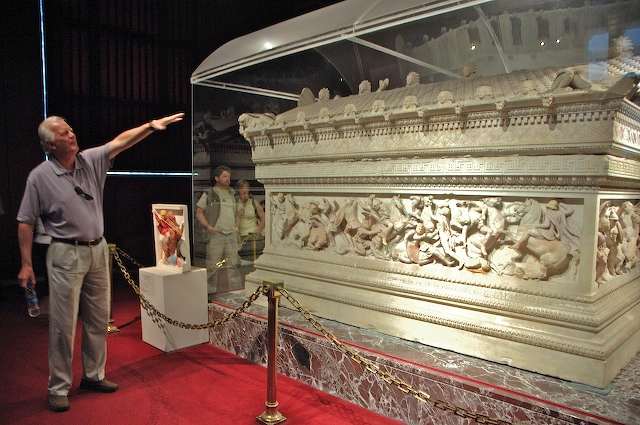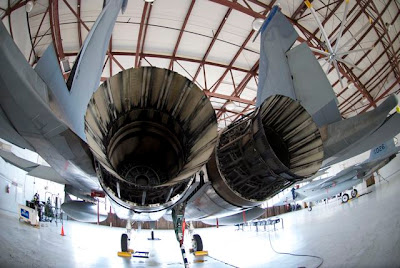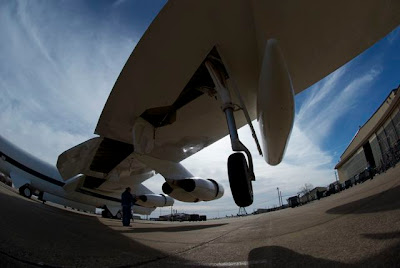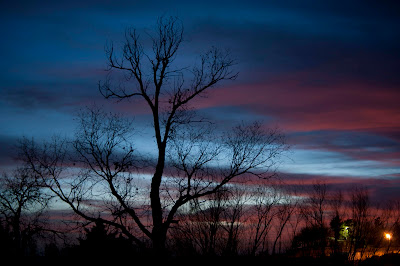Cellphone image of my props while flying over North Central Texas.
Over my nose I sought the runway a bit south of the town of Childress. En route, I looked over my right wing to try to spot Vernon's runways while listening to their AWOS (current weather data), and discovered that while the wind blew to the south there, the wind in Childress blew to the north, despite the small distance of 50 nautical miles between the two towns.
When I arrived in Childress, I did not know where to taxi my plane, except toward an old hangar with its doors wide open. I followed old, faint, yellow lines toward the hangar, and parked in front of it.
Cellphone image of the tail of my plane and a large hangar at the airport in Childress. As I hopped off my wing, bearing my log book, I wondered about whom I would meet, and that surely they would be nice folks. Eventually, a lady emerged from a small building next to the hangar. She was chasing a cat. She waved at me and asked me if she could help me. "Oh, yes!" I said. "I'm on my first leg of my cross-country. Would you sign my logbook for me?" And so we stepped inside the small building, the fixed base operator of Childress, and while Debra signed my logbook, I sipped some good coffee she had just made. "Do you know Mary?" I asked. And Debra said Mary had taught her cousin to fly.
From Childress, I took off to Vernon. I critiqued myself about my pre-take off, finding myself neglectful of an important thing that should become a good habit: Walk around the plane before boarding.
The flight to Vernon took only twenty minutes, which I expected. What I did not expect was to come upon the runways so suddenly. Listening again to their AWOS, hearing the voice say the wind came from the north at a scant five miles per hour, I chose to land on runway 35. Did not like back taxiing toward the fixed base operator on the runway, then having to cross over runway 2, before reaching the parking area. The reason I feel queasy about it, aside from my inexperience flying, is that crop dusters tend to fly around with no radios, and so I don't know their positions. Do they know mine? In flying we rely on looking out the window all over the sky, up and down, side to side, to avoid a mid-air collision. You think you can hardly see a motorcycle on the road? Aircraft look like pinheads in a universe of sky. I've heard a good expression to keep in mind: Keep your head on a swivel.
"Cherokee that just landed Wilbarger will you be needing fuel?"
"Ah, no. Thanks."
I had not shut down my engine when Randy, the source of the voice on the radio, a staff member of Vernon's fixed base operator came bounding out with a set of choks. I climbed out and said, "I'm on a cross-country. Would you sign my logbook for me, please?"
"Sure. You know Lawrence?"
"Yes, I know Lawrence."
"He was just here. He heard you on the radio and said you'd be heading this way."
Inside, I asked Randy if he has seen any Horned Lizards lately.
"Yeah. We see them when we mow."
"I saw one on the taxiway and I think I ran over it. I feel badly about that."
"There's plenty to replace that one."
Now I know of two airports where they make good coffee. I sipped coffee while two young men drove up in a truck and entered the building. They were looking for jobs, and Randy pointed them toward another building.
Before boarding, I walked around my plane to make sure it was good to go. As I sat in the pilot's seat, I watched the wind sock. The AWOS indicated calm winds. Over my cowling lay the wide grasslands that make up North Central Texas, with two runways. I did not want to back taxi to 34, so I taxiid to runway 2, and with a calm crosswind, I took off. As I turned gently to the south-east, I radioed Randy. "Hey, Randy, try not to mow over those horned toads!"

















































